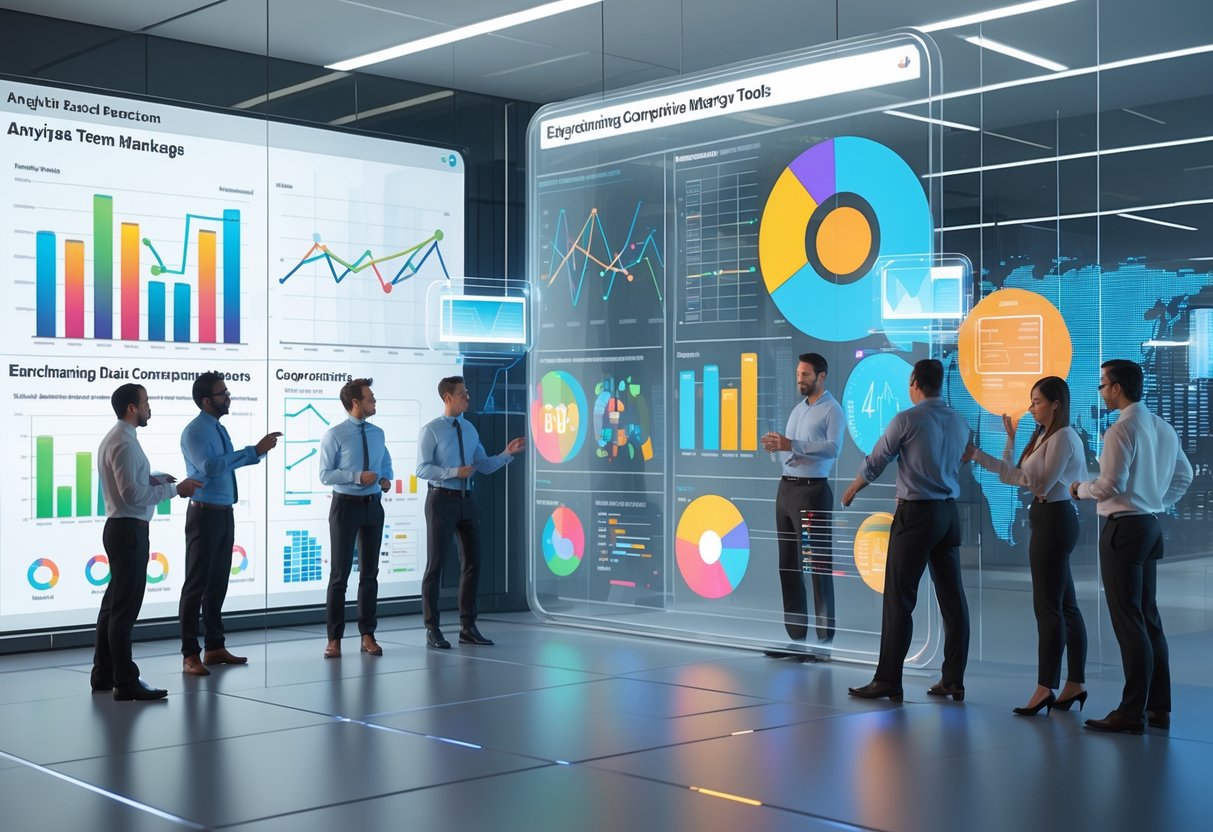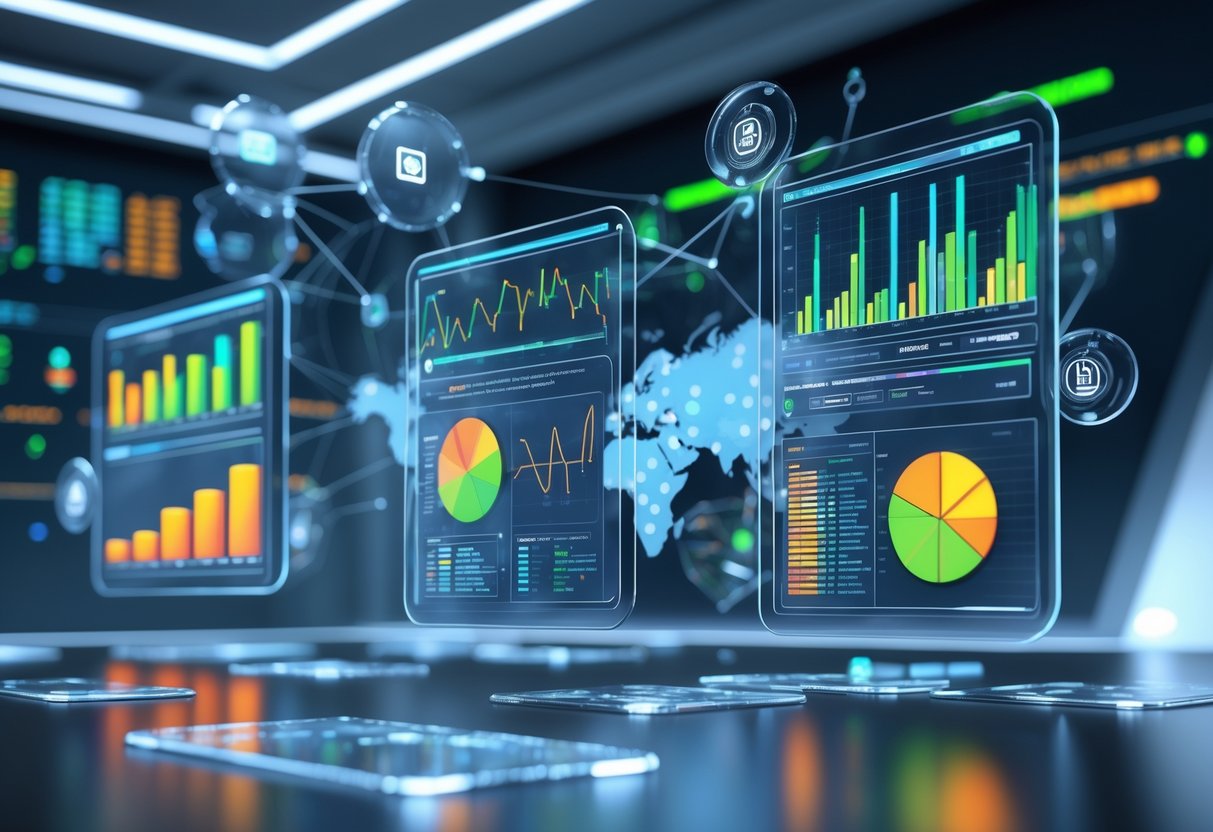Competitive Integrity Tools: Essential Guide for Modern Businesses
Updated On: November 13, 2025 by Aaron Connolly
What Are Competitive Integrity Tools?
Competitive integrity tools are specialized software platforms. They help businesses gather, analyze, and act on information about their competitors and market conditions.
These tools focus on maintaining ethical standards. At the same time, they provide actionable insights for strategic decision-making.
Purpose and Role in Modern Business
Competitive intelligence tools have become the backbone of strategic planning in today’s fast-moving markets. We use these platforms to track competitor activities and monitor market trends.
They also help us spot new opportunities before they become obvious to everyone else.
Key business applications include:
- Market positioning analysis – Figuring out where we stand against competitors
- Product development insights – Spotting feature gaps and innovation opportunities
- Pricing strategy optimization – Keeping an eye on competitor pricing patterns
- Risk assessment – Catching potential threats early
Modern CI tools process data from websites, social media, industry reports, and public databases. They turn raw information into insights that guide decisions about product launches, marketing campaigns, and strategic partnerships.
About 90% of Fortune 500 companies now rely on competitive intelligence. That shows just how critical these tools have become for staying relevant and ahead in the market.
Differences Between Competitive Intelligence and Market Intelligence
People often mix up competitive intelligence and market intelligence, but they serve different purposes. Understanding the differences helps us pick the right tools and methods.
Competitive Intelligence focuses on:
- Specific competitor activities and strategies
- Direct competitor product features and pricing
- Sales performance comparisons
- Competitor marketing campaigns and messaging
Market Intelligence concentrates on:
- Overall industry trends and forecasts
- Customer behavior patterns across the market
- Regulatory changes affecting the sector
- Economic factors shaping market conditions
| Aspect | Competitive Intelligence | Market Intelligence |
|---|---|---|
| Scope | Specific competitors | Entire market ecosystem |
| Timeline | Real-time competitor moves | Long-term market trends |
| Data Sources | Competitor websites, reviews | Industry reports, surveys |
| Output | Competitor profiles, benchmarks | Market forecasts, trend analysis |
Most businesses use both approaches. We rely on competitive intelligence for quick, tactical decisions and market intelligence for long-term planning.
Key Types of Competitive Integrity Tools
Modern competitive intelligence platforms come in several categories. Each one serves a different business need.
We can group these tools by their main functions and data sources.
SWOT Analysis Platforms help us assess our competitive position. Tools like Visual Paradigm Online and Lucidchart offer templates for comparing strengths and weaknesses.
Market Research Tools gather broad industry data:
- ZoomInfo tracks personnel changes in 1.5 million companies daily.
- Semrush analyzes digital marketing performance for over 87,000 customers.
- Similarweb covers 190+ countries and 210 industries.
- Statista provides research across 170 industries.
Social Media Monitoring Solutions like Meltwater Radarly use AI to track brand mentions and sentiment. They also keep an eye on competitor social strategies in real-time.
Data Visualization Platforms turn raw intelligence into useful insights:
| Tool | Best For | Starting Price |
|---|---|---|
| Tableau | Advanced visualizations | £70 per user |
| Microsoft Power BI | Deep data analysis | £10 per user |
| Infogram | Simple, non-technical use | Free tier available |
| Grafana | Real-time dashboards | £49 |
Warning: The data visualization market keeps growing fast. It could hit £19.20 billion by 2027, so picking the right tool is getting trickier.
These tools work best when used together. Most successful businesses combine several tool types, not just one.
Critical Features of Competitive Integrity Tools

The best competitive intelligence platforms share four must-have features. These capabilities help turn raw market data into real business insights.
They automate data gathering, present findings clearly, and fit right into your current business operations.
Real-Time Data Collection
Modern competitive intelligence tools need to capture market changes as they happen. Real-time tracking sends instant alerts when competitors update pricing, launch campaigns, or change their messaging.
The top platforms monitor multiple data sources at once. This includes competitor websites, social media, press releases, and customer reviews.
AI tools scan these sources nonstop, flagging important changes within minutes.
Automated data collection saves your team from checking competitor sites every day. The software handles it, so you can focus on analysis, not grunt work.
Key data sources include:
- Competitor website changes
- Social media activity and engagement
- Customer reviews and ratings
- Press releases and news mentions
- Job postings and hiring patterns
If you don’t collect data in real time, you’ll always play catch-up.
Data Visualization and Reporting
Raw data isn’t helpful unless you can see what it means. Data visualization turns thousands of data points into charts, graphs, and dashboards your team can actually use.
Good visualization tools show trends over time, not just single moments. We can compare our performance against competitors with clear metrics like review scores or website traffic.
The best platforms offer dashboards tailored for each team. Sales needs battlecards with competitor pricing. Marketing wants social media comparisons. Executives prefer high-level summaries.
Interactive reporting lets you dig deeper from overview dashboards into details. For example, clicking a competitor’s review score reveals individual complaints and praise.
Key visualization features include:
- Side-by-side competitor comparisons
- Trend analysis over different time periods
- Customizable KPIs and metrics
- Mobile-friendly dashboard access
Automation Capabilities
Manual competitive analysis can’t keep up as your business grows. Automation takes care of routine monitoring and spots patterns people might miss.
AI tools can sort competitor content, detect shifts in customer sentiment, and flag odd activity. This includes sudden jumps in social activity or big changes in messaging.
Smart automation also sends out regular reports automatically. Weekly summaries, monthly benchmarks, and quarterly overviews all run on their own.
Predictive automation finds early warning signs. These systems spot patterns that usually come before major competitor moves, giving you a heads-up.
Automation features include:
- Scheduled competitive reports
- Anomaly detection and alerts
- Automatic competitor identification
- Pattern recognition and forecasting
- Sentiment analysis across platforms
A quick tip: Set up automated weekly reports to track your top three competitors’ key stats.
Integrations with Business Systems
Competitive intelligence only helps when decision-makers get it fast. Seamless integrations connect intelligence tools with your existing systems like CRM, project management, and communication platforms.
Popular integrations include Slack for instant alerts, Salesforce for competitor data in customer records, and HubSpot for marketing insights. These links make sure competitive intelligence fits naturally into your workflow.
API connectivity lets you create custom integrations with your own systems. Competitive data can flow straight into internal dashboards or executive reports.
Advanced platforms even automate tasks between systems. If a competitor launches a new product, the tool can create a task in your project manager and alert the right people.
Common integration points:
- CRM systems for sales intelligence
- Marketing automation platforms
- Communication tools (Slack, Teams)
- Business intelligence dashboards
- Project management software
You often get the best insights when you combine competitive data with your own business metrics. That way, you see the full picture.
Top Competitive Integrity Tools and Solutions

Modern competitive intelligence needs strong tools that gather, analyze, and deliver actionable insights about rivals in real time. These platforms blend automated monitoring with human analysis so businesses can track competitor moves, pricing changes, product launches, and market positioning.
Crayon
Crayon stands out as a comprehensive platform for enterprise teams. It automatically tracks competitor websites, pricing, product announcements, and marketing campaigns.
Key Features:
- Real-time competitor monitoring across websites and digital channels
- Automated battlecards for sales teams
- Custom alerts for pricing changes and product updates
- Integration with CRM systems like Salesforce
Crayon turns competitor data into materials that help sales teams win more deals. Sales gets notified right away when competitors change pricing or launch new features.
Crayon scales monitoring across hundreds of competitors at once. Machine learning picks out the important stuff and filters out noise.
Pricing starts at about £1,200 per month for basic plans. Enterprise features use custom pricing based on how many competitors you track and team size.
Semrush
Semrush is a digital marketing intelligence powerhouse with strong competitive analysis features. It started as an SEO tool but now covers paid ads, social media, and content marketing too.
Core Competitive Features:
- Organic Research: Track competitors’ best keywords and rankings
- Advertising Research: Monitor their paid search campaigns and budgets
- Backlink Analysis: See their link-building strategies
- Content Gap Analysis: Find keyword opportunities they’re missing
Digital marketing teams get the most out of Semrush. You can see which keywords drive traffic to competitor sites and how much they spend on Google Ads.
Semrush’s Traffic Analytics estimates competitor website traffic and engagement. You can use this data to benchmark your own performance.
Plans start at £99 per month for basic research. If you want advanced features like historical data or API access, expect to pay more.
BuzzSumo
BuzzSumo focuses on content marketing intelligence and social media monitoring. It tracks viral content, influencer partnerships, and social engagement for competitor brands.
Primary Functions:
- Content performance analysis across social platforms
- Influencer identification and tracking
- Brand mention monitoring
- Trending topic discovery
The tool shows you which competitor content gets the most shares and engagement. You can break down their strategy by topic, format, and timing.
BuzzSumo’s Alerts feature sends notifications when rivals publish high-performing content or work with new influencers.
You can integrate BuzzSumo with other tools like Meltwater for broader media monitoring. Pricing starts at £79 per month for basic research.
Klue
Klue calls itself an end-to-end competitive enablement platform for sales and marketing teams. It combines automated intelligence gathering with expert human analysis.
Distinctive Capabilities:
- Compete Cards: Automated competitor profile updates
- Win-Loss Analysis: Track deal outcomes against specific competitors
- Sales Training: Role-playing scenarios using real competitor data
- Custom Research: On-demand analyst support for tricky questions
Klue’s dedicated researchers check automated findings for accuracy. This human touch means you get more reliable intel than with purely automated tools like VisualPing.
The platform fits right into sales tools, so reps get competitor insights when they need them. Contextual battlecards pop up during deals.
Custom pricing depends on company size and research needs. Expect enterprise-level costs for full-service support.
Competitor Tracking and Analysis

Tracking competitors in esports means watching their team activities, understanding their place in the market, and analyzing pricing strategies. These three things give teams the info they need to make smart moves and find their edge.
Competitor Activity Monitoring
Competitor activity monitoring keeps tabs on what rival teams and organizations do every day. That includes roster changes, training schedules, sponsor news, and social media posts.
We monitor competitor activities through several channels. Social media tracking shows us when teams announce new players or partnerships.
Tournament databases reveal which events competitors enter and how they perform.
Streaming platforms like Twitch let us peek into training habits. Many pro teams stream their practice, giving us a look at their strategies and team dynamics.
Key monitoring areas include:
- Roster changes and player transfers
- Training schedules and bootcamp locations
- Sponsor partnerships and contract renewals
- Tournament participation and results
- Social media engagement rates
Tools like Brand24 and Mention track online mentions of competitor teams. They send alerts when rivals get media coverage or spark fan discussions.
Regular monitoring builds a database of competitor behavior patterns. This data helps us predict future moves and spot new opportunities.
Market Share Analysis
Market share analysis checks how much of the esports market each competitor really controls. We look at tournament winnings, fan following, viewership numbers, and sponsor revenue.
We track market share using several metrics. Tournament earnings highlight which teams scoop up the biggest prize pools.
Viewership data shows which organisations actually draw in the most fans during matches.
Social media followers reflect brand strength. Honestly, a team with 2 million Twitter followers just has more marketing value than one sitting at 200,000.
Market share indicators include:
- Prize money won across tournaments
- Social media follower counts
- Average match viewership numbers
- Merchandise sales figures
- Sponsor deal values
| Metric | Team A | Team B | Team C |
|---|---|---|---|
| Prize Money (2024) | £850k | £620k | £340k |
| Twitter Followers | 2.1M | 1.8M | 950K |
| Avg. Viewership | 120K | 85K | 45K |
This kind of benchmarking makes market positioning obvious. Teams can spot where they might catch up or notice areas where they’re lagging behind.
Pricing Strategies Tracking
Pricing strategies tracking looks at how competitors set prices for merchandise, coaching, and fan experiences. This info helps organisations position their own offerings in a smarter way.
We keep an eye on competitor pricing across different revenue streams. Merchandise pricing jumps a lot between top-tier and smaller teams.
Coaching services? Those show even more dramatic differences.
Tournament entry fees and bootcamp costs also offer pricing clues. Some teams charge premium rates for training partnerships, while others keep things competitive to bring in more clients.
Pricing areas to monitor:
- Team merchandise (jerseys, accessories)
- Coaching and training services
- Bootcamp and facility rental
- Sponsorship package rates
- Fan meet-and-greet events
Price tracking uncovers market trends. If several competitors raise coaching fees, that usually means the market’s okay with higher rates.
But if prices drop, maybe there’s oversupply or just economic pressure.
Regular pricing analysis helps teams avoid pricing themselves out of the market or selling themselves short. The data backs up decisions that maximise revenue but keep them competitive.
Analysing Market Trends and Benchmarking

Understanding market trends and benchmarking performance helps esports organisations stay in the game and spot growth chances. These processes give you the data you need to make smart calls about team investments, content, and positioning.
Trend Analysis Methods
Real-time data tracking sits at the core of good trend analysis. Teams keep tabs on viewership numbers, social engagement, and tournament attendance across games and regions.
Games like Valorant show clear seasonal patterns in viewership. These spikes often line up with major tournaments or new patches.
Social listening tools pick up on fan sentiment and hot topics. Platforms track mentions of teams, players, and games across Twitter, Reddit, and Discord.
Key metrics include:
- Tournament viewership trends (peak hours, drop-off rates)
- Player transfer activity (salary inflation, regional movement)
- Sponsorship deal values (brand investment patterns)
- Content consumption habits (YouTube vs Twitch preferences)
Many organisations use Google Trends to spot rising game titles before they go mainstream. Catching these early helps teams lock down talent and sponsors.
Industry Benchmarking
Performance comparison tells teams where they stand. Teams look at win rates, fan engagement, and revenue compared to similar organisations.
Common benchmarks include average social followers by league position and merchandise sales versus tournament success. Top teams usually get 3-5 times more engagement than those in the middle.
Financial benchmarking digs into salary structures, costs, and revenue streams. European teams often compare themselves to North American ones to see what’s different.
Key comparison areas:
- Player salaries by role and experience
- Content creation output (videos per week, stream hours)
- Partnership deals (duration, exclusivity)
- Fan base growth rates (monthly follower increases)
Teams use tools like SimilarWeb to check competitor website traffic and see what content works. This info helps them spend smarter on marketing and plan content.
Forecasting Market Shifts
Predictive analysis mixes old data with current trends to guess where the market’s heading. Teams track announcements from developers, tournament changes, and where money’s flowing by region.
Mobile esports in Southeast Asia shows how early predictions pay off. Teams that jumped in early landed the best partnerships.
Innovation indicators point out new opportunities. Streaming platforms, VR, and blockchain gaming all look like areas to watch.
Warning signs include:
- Falling viewership for big titles
- Less publisher support (smaller prize pools, fewer tournaments)
- Regulatory shifts affecting betting or streaming
- Tech changes (new platforms, different viewing experiences)
Sustainable growth means balancing quick wins with long-term stability. Teams spread out across games and revenue streams to handle market swings.
Smart organisations do scenario planning for different market conditions. That way, they can adapt fast when things shift.
Media Monitoring and Social Listening
Tracking what people say about your esports organisation on social and news platforms helps you protect your reputation and spot issues before they blow up. Let’s look at how to monitor mentions effectively, understand audience sentiment, and measure how your content performs.
Tracking Media Mentions
Media monitoring tools scan thousands of sites, social platforms, and forums to catch every mention of your team. Tools like Brand24 and BrandMentions send real-time alerts when someone talks about your brand.
Key platforms to monitor:
- Twitter/X conversations about matches
- Reddit threads in gaming communities
- Twitch chat during streams
- YouTube video comments
- Gaming news websites and blogs
Set up alerts for your team name, player handles, and even common misspellings. Many esports organisations also keep tabs on mentions of rival teams to see how they’re stacking up.
Most monitoring tools cost between £49-299 per month, depending on how much you want to track. Free options like Google Alerts cover the basics but miss a lot, especially on social.
Heads up: Don’t just watch for praise. Negative feedback often tells you what fans really want.
Sentiment Analysis in the Media
Knowing if mentions are positive, negative, or neutral helps you respond the right way. Modern tools use AI to sort customer sentiment across tons of mentions.
Sentiment patterns to watch:
- Positive spikes usually come after tournament wins or hit content drops
- Negative trends can signal issues with player behaviour or bad results
- Neutral mentions often just report match outcomes or roster moves
Tools like Hootsuite and YouScan give you sentiment scores so you can see if your brand image is going up or down. That helps you measure PR campaigns or crisis responses.
Perceptions can shift fast in esports. One bad tweet or a rough tournament can trigger hundreds of negative mentions in no time.
Quick tip: Set up special alerts for really negative sentiment. That way, you can step in before things spiral.
Measuring Content Performance
Content performance metrics tell you which posts actually get fans talking and what insights you can pull from that. Go beyond just likes and shares to really understand how your audience reacts.
Essential metrics to monitor:
| Metric | What it Measures | Good Performance |
|---|---|---|
| Engagement rate | Likes, comments, shares per follower | Above 3% |
| Sentiment ratio | Positive vs negative comments | 70%+ positive |
| Share velocity | How quickly content spreads | Doubling every 2-4 hours |
| Mention reach | Total people who saw mentions | 10x your follower count |
Video content almost always outperforms for esports fans. Match highlights, behind-the-scenes clips, and player interviews get way more engagement than static posts.
Use tools like BuzzSumo to see which content formats click with your community. Different games have their own content quirks—Counter-Strike fans love tactical breakdowns, while League of Legends folks are all about personality-driven stuff.
Next up: Pick a monitoring tool and set up alerts for your org and three main rivals to start building your baseline data.
Harnessing Customer Feedback and Insights

Customer feedback keeps competitive integrity honest by showing what players actually experience, not just what we think we’re delivering. We can turn raw feedback into real insights that boost player satisfaction and drive product improvements.
Collecting and Analysing Customer Feedback
We need a bunch of channels to catch all the player feedback across different touchpoints. Surveys are great for structured data, while social media monitoring grabs those off-the-cuff reactions during live events.
Real-time feedback during tournaments is gold. Quick polls between matches or instant reactions to rule tweaks via mobile apps work well.
Modern AI tools help us sift through tons of unstructured feedback. They spot patterns in complaints, flag new issues, and catch sentiment shifts before they grow.
Key collection methods:
- Post-match surveys for players and viewers
- Social media sentiment tracking
- Community forum analysis
- Direct interviews with team managers
- Live chat monitoring during streams
We should analyse feedback data weekly, not just monthly. That way, we catch trends early and fix issues before they hurt integrity.
Improving Customer Satisfaction
Player satisfaction affects tournament credibility and how many viewers stick around. We need to address feedback systematically, not just react to the loudest voices.
Priority ranking helps us fix the biggest issues first. Technical problems like lag or server crashes usually hit satisfaction harder than minor rule debates.
We build feedback loops by telling the community what we’ve changed. When players see their input matter, they’re more likely to keep sharing feedback.
Fast responses really count in esports. Players expect a reply within hours—especially during live events.
Satisfaction improvement strategies:
- Set 24-hour targets for technical issue responses
- Share public roadmaps for planned fixes
- Build player advisory panels for big decisions
- Give regular updates on ongoing improvements
We track metrics like Net Promoter Scores, player retention, and complaint trends to see if we’re making progress.
Using Feedback for Product Development
Customer insights should drive competitive format tweaks and rule changes. Player feedback often shows gaps between what we want the game to be and what it actually is.
We set development priorities based on how often feedback comes up and how big the impact is. If a bunch of teams complain about tournament scheduling, it’s probably a real problem.
Beta testing with select communities lets us test changes before rolling them out to everyone. That helps us avoid new headaches.
Feedback shows us what features players care about most. Sometimes, we realise simple fixes matter more than fancy new systems.
Development integration methods:
- Weekly feedback review meetings
- Player advisory input on rule changes
- A/B testing for format tweaks
- Community votes on proposed features
We keep records of feedback patterns to guide future decisions. Looking back helps us predict reactions and dodge old mistakes.
Strategic Decision-Making with Competitive Integrity Tools

Competitive intelligence tools change how we make key business decisions by giving us data-driven insights for product and marketing strategies. These tools help us spot market gaps and build growth plans that actually respond to real competitor activity and customer needs.
Supporting Product and Marketing Innovation
We use competitive intelligence tools to spot innovation opportunities our rivals overlook. Market research platforms like ZoomInfo and Semrush show us competitor product launches, feature gaps, and customer complaints, which guide our development priorities.
Product Development Insights:
- Feature requests competitors ignore
- Pricing gaps in the market
- Customer pain points in reviews
- Technical specs that drive sales
Social media tracking tools let us watch how customers react to competitor products. This feedback tells us what features people actually care about, not just what companies think they want.
For marketing innovation, we track competitor campaigns across all channels. Data visualisation tools like Tableau help us map out competitor messaging and spot positioning opportunities.
Marketing Strategy Applications:
- Campaign timing that avoids direct clashes
- Messaging angles competitors haven’t tried
- Channel strategies with less noise
- Content gaps our audience still wants filled
AI-powered prediction tools help us forecast which innovations might catch on. We look at competitor patent filings, hiring trends, and R&D investments to guess their next moves.
Driving Sustainable Business Growth
Strategic choices need both immediate insights and a sense of where the market’s heading. We use competitive intelligence to build growth strategies that adapt to shifting competitor behaviour and changing conditions.
Performance benchmarking gives us realistic growth targets. We compare our numbers against competitors in three main areas:
| Growth Area | Benchmarking Focus | Strategic Impact |
|---|---|---|
| Market share | Revenue trends vs competitors | Shows expansion opportunities |
| Customer retention | Churn rates and satisfaction scores | Reveals where we can improve service |
| Operational efficiency | Cost structures and margins | Highlights where to optimise resources |
Competitor profiling tools track pricing, product updates, and market shifts. This info helps us act before we have to react.
We also keep an eye on competitor hiring and leadership changes. New executives often signal a shift in direction that could affect our market position.
Sustainable Growth Metrics:
- Competitive displacement rates
- Market share growth over time
- Improvements in customer acquisition cost
- Win/loss ratios against specific competitors
Risk assessment works better when we know competitor strengths and weaknesses. We find market segments where competitors struggle and focus our resources there.
Data Visualisation and Dashboarding

Effective competitive intelligence tools turn complex market data into clear visuals. Modern dashboards show key performance indicators through interactive charts and real-time displays that people actually use.
Visualising Competitive Data
Raw competitive data doesn’t mean much without good visualisation. The best tools turn competitor pricing, market share, and activity data into charts that reveal patterns right away.
Heat maps do a great job of showing competitor activity in different markets. They highlight where rivals put the most effort.
Interactive scatter plots help us track competitor positioning over time. You can see how their pricing changes or where new gaps open up.
Essential visualisation features:
- Real-time competitor tracking charts
- Market share comparison graphs
- Pricing trend analysis displays
- Social media sentiment maps
- Traffic and engagement comparisons
Many platforms offer drag-and-drop chart builders. You can customise displays without needing technical skills. Auto-charting features suggest the best visual format based on your data.
The best tools let you drill down on any data point. Click to see all the details behind the numbers.
KPI Dashboards for Stakeholders
Different stakeholders want different competitive intelligence views. Sales teams care about pricing comparisons, while executives focus on market positioning trends.
Executive dashboards highlight high-level key performance indicators like market share changes, competitive threats, and opportunity scores.
Sales dashboards put competitor pricing and product features front and centre. Marketing teams need social media metrics and campaign tracking.
Critical dashboard elements:
- Customisable widgets for each user role
- Alert systems for big competitor changes
- Automated reporting for regular updates
- Mobile-responsive designs for easy access
The best platforms let users personalise their dashboards. You can save different layouts for meetings or reports.
Interactive dashboards beat static reports every time. Stakeholders can filter data, change time ranges, and dig into specific competitors without waiting for a new report.
Evaluating and Comparing Competitive Intelligence Tools

Choosing the right competitive intelligence software means looking closely at your organisation’s needs and budget. The evaluation process should focus on functionality, integration, and long-term value—not just the length of a feature list.
Choosing the Right Tool for Your Organisation
Organisation size matters a lot when picking competitive intelligence software. Small businesses usually get the most from affordable options like SpyFu or BuzzSumo, which start around £30-80 a month.
Mid-sized companies need more features. Tools like Semrush or Ahrefs offer broader sets for £90-120 monthly.
Large enterprises want robust platforms with advanced AI and real-time tracking. Crayon and Brandwatch provide enterprise solutions starting at £600+ per month.
Industry focus really matters. E-commerce businesses should look for strong SEO analysis like Ahrefs. Social media companies get more from Brandwatch’s sentiment analysis.
Tech startups need mobile app intelligence from Data.ai. B2B companies often pick Klue for team collaboration features.
Think about your team’s technical skills. Some platforms need lots of training, while others have simple interfaces you can use right away.
Factors for Evaluation and Customisation
Functionality assessment means checking core features against what you actually need. Must-haves include real-time competitor monitoring, market trend analysis, and customisable reports.
AI tools integration is now a key part of modern competitive intelligence. Look for platforms with automated insights, predictive analytics, and smart alerts that save you manual effort.
Data accuracy and sources matter a lot for good decisions. Make sure your tools pull reliable, up-to-date info from credible sources.
Integration makes your workflow smoother. Check that chosen software connects with your CRM, marketing platforms, and analytics tools.
Pricing structures vary wildly. Calculate the total cost, including licences, training, and extra features. Most platforms offer free trials, so try before you commit.
Customer support quality can make or break your success. Prioritise vendors with solid training, fast technical support, and regular updates.
Content and Influencer Analysis

Understanding how competitors structure their content and work with influencers reveals the strategies behind their success. We track which creative formats perform best and spot the key personalities shaping audience engagement in our space.
Assessing Competitor Content Strategies
We start by tracking what types of content competitors post and when they share it. Content performance data tells us which posts get the most likes, shares, and comments.
Most competitor analysis tools let us sort content by engagement. This makes it easy to spot patterns. For instance, we might see that video content outperforms static images.
We also track posting frequency. Some brands post daily, others stick to fewer, higher-quality posts. The data shows which approach works in our niche.
Key metrics to monitor:
- Engagement by content type
- Posting times and frequency
- Hashtag performance
- Comment sentiment
Tools like BuzzSumo and Rival IQ generate insights about top-performing content. They show which formats drive the most shares and engagement over time.
Identifying Key Influencers
We need to know which influencers our competitors use most. This shows us who really influences our market and which partnerships actually work.
Influencer tracking tools show engagement rates, audience demographics, and whether posts are sponsored or organic. HypeAuditor and others check influencer authenticity so we can avoid fake followers.
We track which influencers create content for several competitors. These creators often have the biggest impact on our target audience. Their style and messaging can guide our own partnerships.
Important factors to assess:
- Audience overlap with our targets
- Engagement on sponsored posts
- Content quality and brand fit
- Follower authenticity
Many tools also offer sentiment analysis on influencer content. This tells us how audiences truly feel about sponsored posts and brand partnerships.
Ad Creatives Monitoring
Tracking competitor ad creatives helps us understand which messages and visuals work in paid campaigns. We can see which ads run longest, hinting at good performance.
Facebook Ad Library and similar tools show active ads from any brand. We get to see headlines, images, and video content competitors use. This gives us a look at their messaging.
We note which creative formats competitors test most. Video ads, carousel posts, and static images all work differently depending on the audience and platform.
Elements to track:
- Ad copy and headlines
- Visual styles and branding
- Call-to-action buttons
- Campaign duration
Tools like Phlanx help us track ad performance across platforms. We see which creatives get shared organically, even if they started as paid content.
The data shows us seasonal patterns as well. Competitors often change their approach during peak buying times or big industry events.
Frequently Asked Questions

These questions tackle the main challenges players and developers face when keeping competitive gaming fair. From detecting cheaters to handling player reports, these tools and methods help protect the integrity of online competition.
How can we detect and prevent cheating in online games?
Anti-cheat systems use several detection methods to catch cheaters. Server-side monitoring tracks weird player behaviour like impossible movement speeds or perfect aim. Client-side scanning checks for known cheat software running on players’ computers.
Machine learning algorithms analyse gameplay data to spot suspicious activity. These systems compare player performance against normal human limits and flag accounts with sudden skill jumps or inhuman reaction times.
Real-time monitoring catches cheaters during matches. Behavioural analysis looks at mouse movement and decision patterns. Automated systems can ban obvious cheaters within minutes.
What are the most effective methods for maintaining fair play in eSports tournaments?
Tournament organizers set up controlled environments to prevent cheating. Players compete on provided hardware with monitored internet connections. Officials watch competitors directly during matches.
Software restrictions block unauthorised programmes on tournament computers. Network monitoring stops outside communication during games. Referees can pause matches to investigate suspicious plays right away.
Pre-tournament hardware checks make sure all equipment meets standards. Players hand over personal devices before competing. These steps create a level playing field where skill matters most.
What steps are game developers taking to address in-game exploits?
Developers release regular patches to fix exploits as soon as they spot them. Bug bounty programmes reward players who report issues responsibly. Teams prioritise fixes based on how much exploits affect competitive balance.
Automated testing checks for new exploits before updates go live. Community feedback helps spot problems quickly after patches. Developers sometimes disable broken features temporarily while working on permanent fixes.
Public test servers let players find exploits before updates reach live games. Beta testing with pro players helps catch balance issues early.
Can you suggest any reliable third-party anti-cheat software?
BattlEye protects popular games like Rainbow Six Siege and PUBG. Easy Anti-Cheat guards Fortnite and Fall Guys, among others. These systems work at the kernel level to detect advanced cheats.
Vanguard from Riot Games protects Valorant with always-on monitoring. FairFight uses stats analysis to catch cheaters in Battlefield games. Each system has its own strengths and compatibility quirks.
Most third-party solutions need admin access to your computer. They might conflict with some legit software or hardware. Always check requirements before installing anti-cheat programmes.
How do player reports contribute to upholding competitive integrity?
Player reports help catch cheaters that automated systems miss. Human reviewers can spot subtle cheating patterns that algorithms overlook. Report systems let the community help police their own games.
Effective reporting needs detailed info about suspected cheating. Screenshots, match replays, and timestamps help investigators check claims. False reports waste resources, so accuracy matters.
Many games use reputation systems with reports. Players with good standing have their reports weighted more. This stops abuse and encourages quality moderation.
In what ways do updates and patches help to maintain a balanced competitive environment?
Balance patches tweak overpowered weapons, characters, or strategies. Developers usually look at win rates and usage stats to figure out what needs to change.
Regular updates shake up the meta and stop things from getting stale. Nobody wants to play the same game forever, right?
Bug fixes get rid of weird advantages that some players exploit. When devs patch these issues, they keep the competition about skill—not just finding loopholes.
Performance updates help everyone play on a level technical field. It’s only fair if everyone deals with the same game conditions.
Community feedback often pushes balance decisions in the right direction. Developers also listen to pro players to understand what the top competitors need.
Patch notes explain the changes so players can adjust their strategies. It’s not always easy, but at least everyone gets a heads-up.

